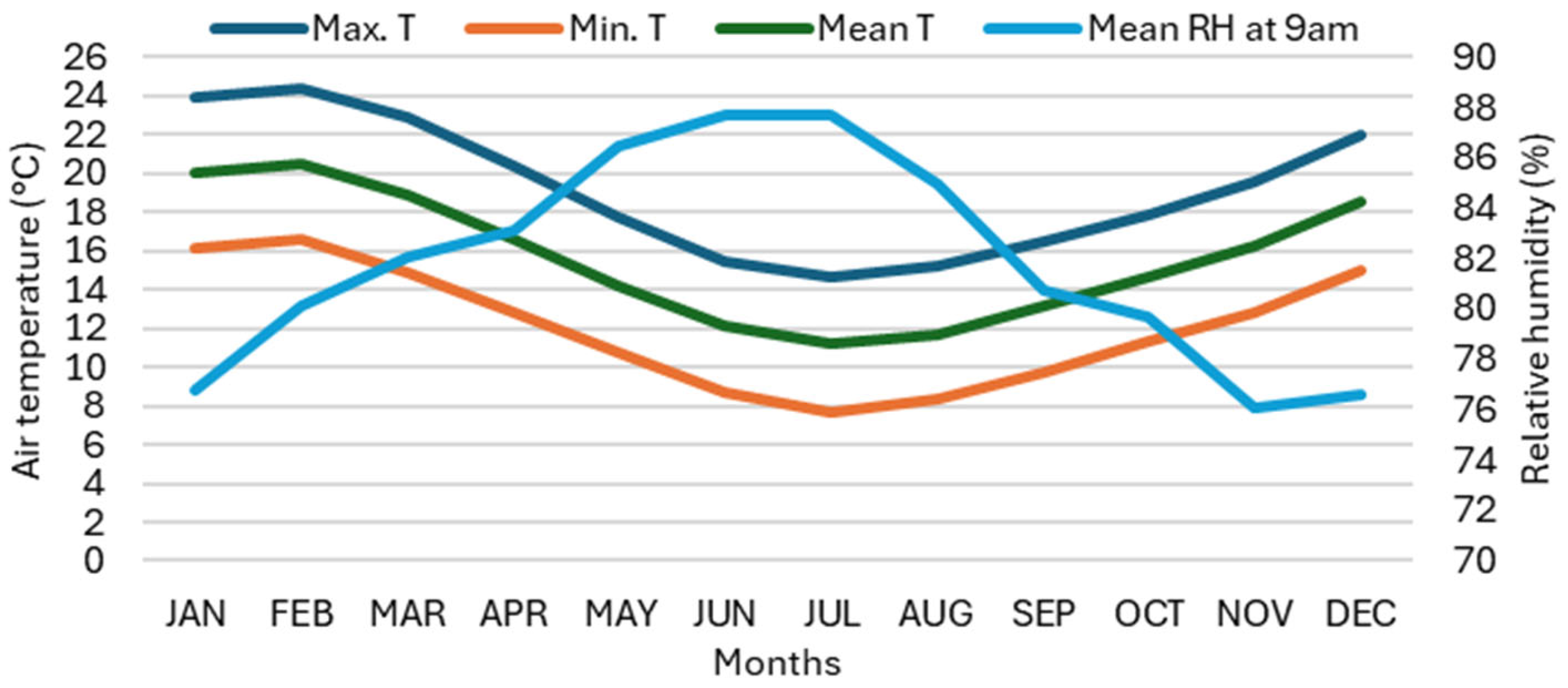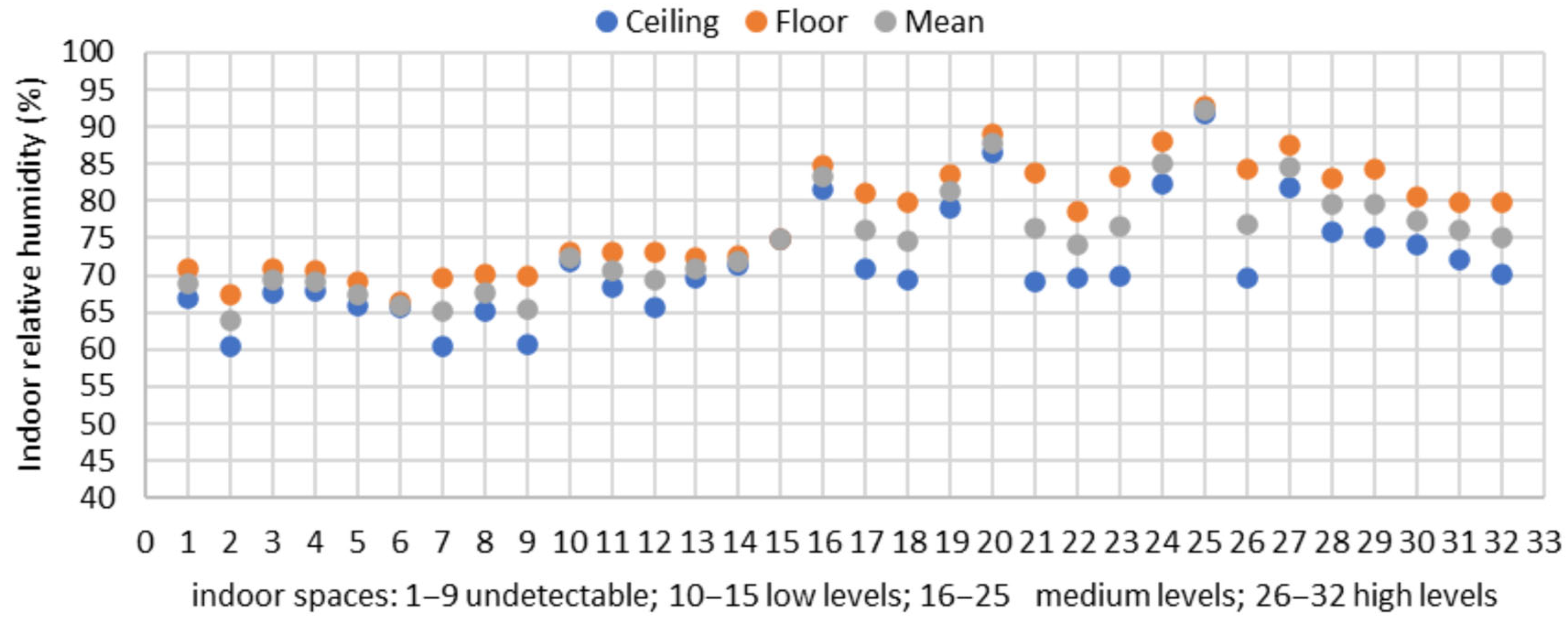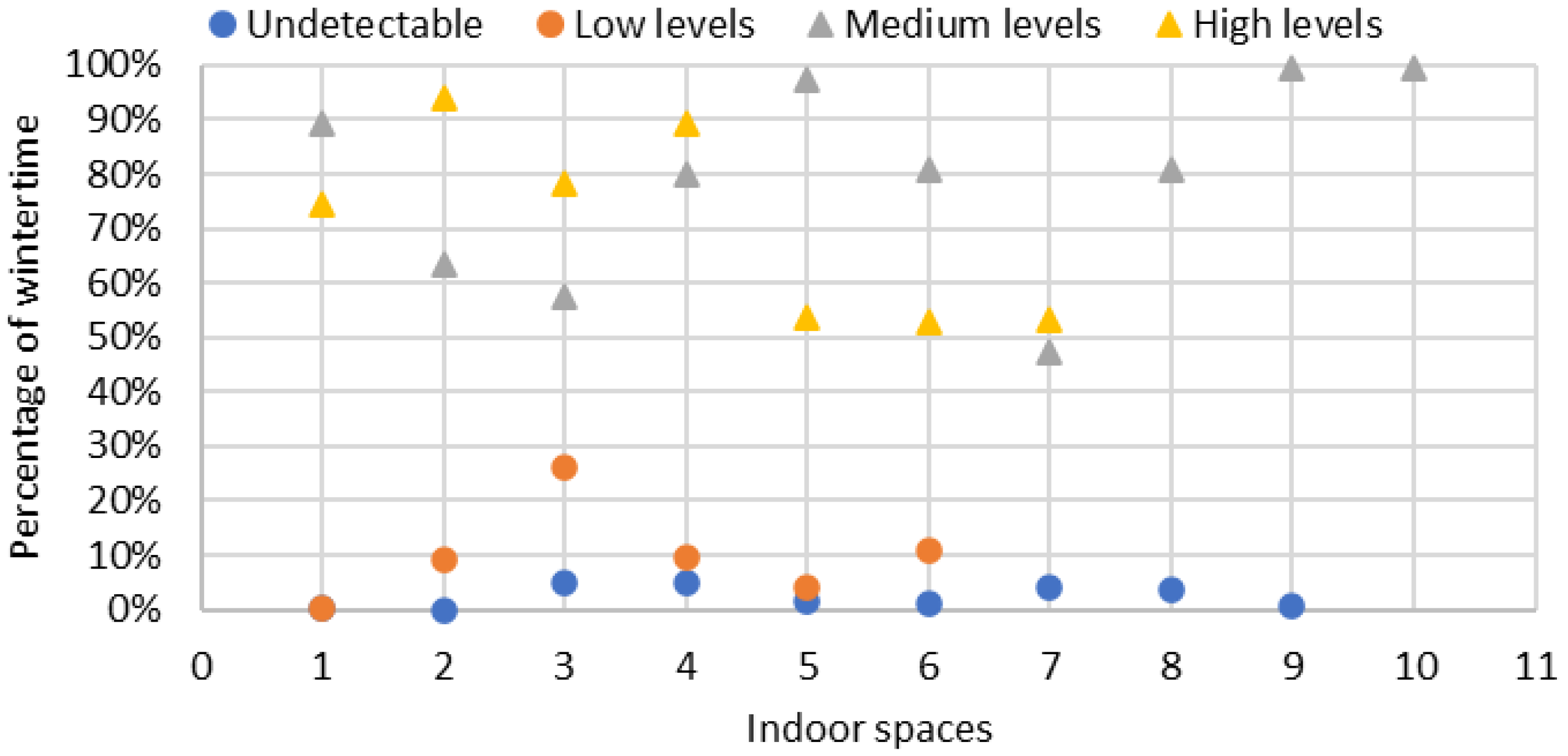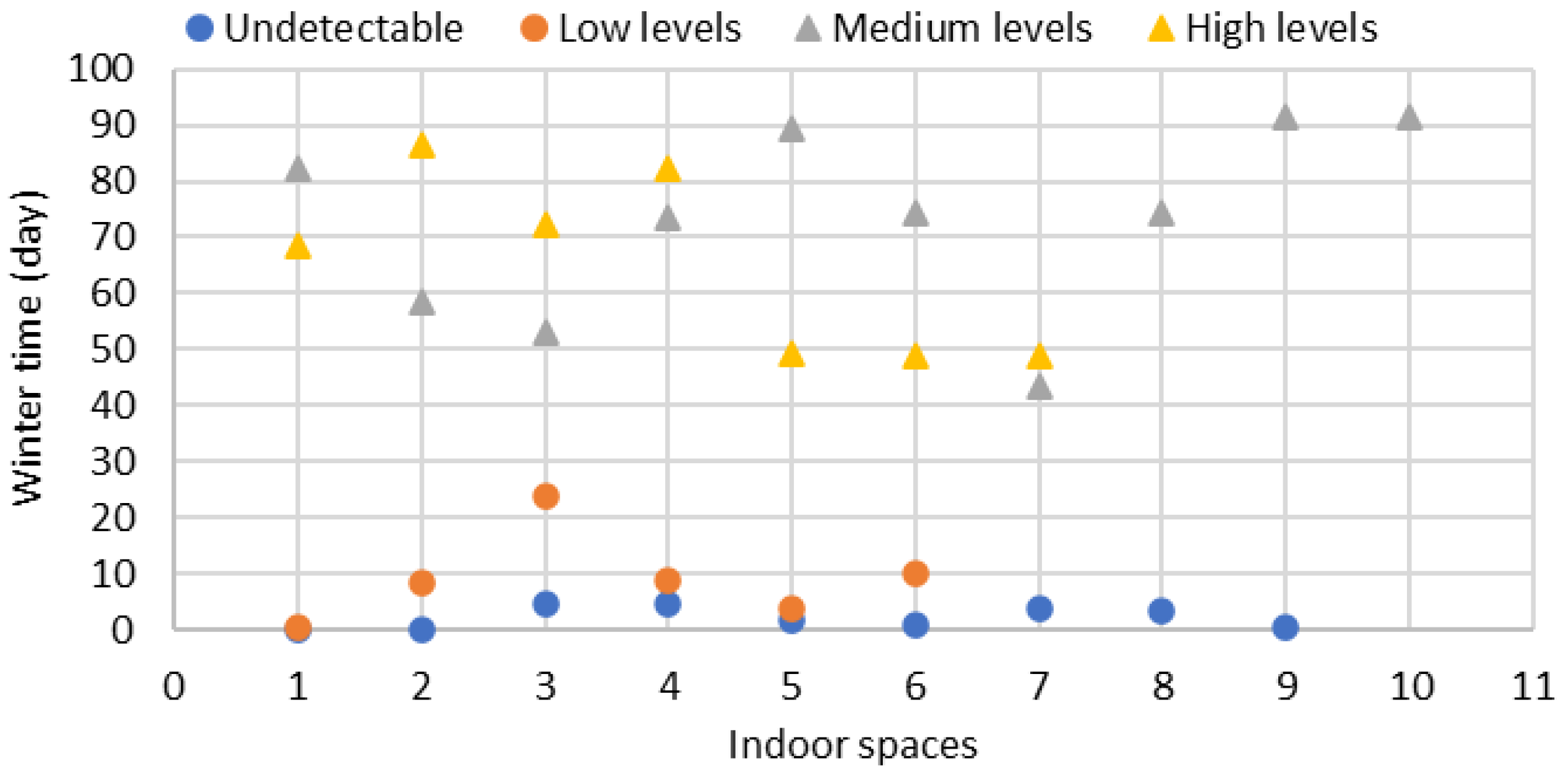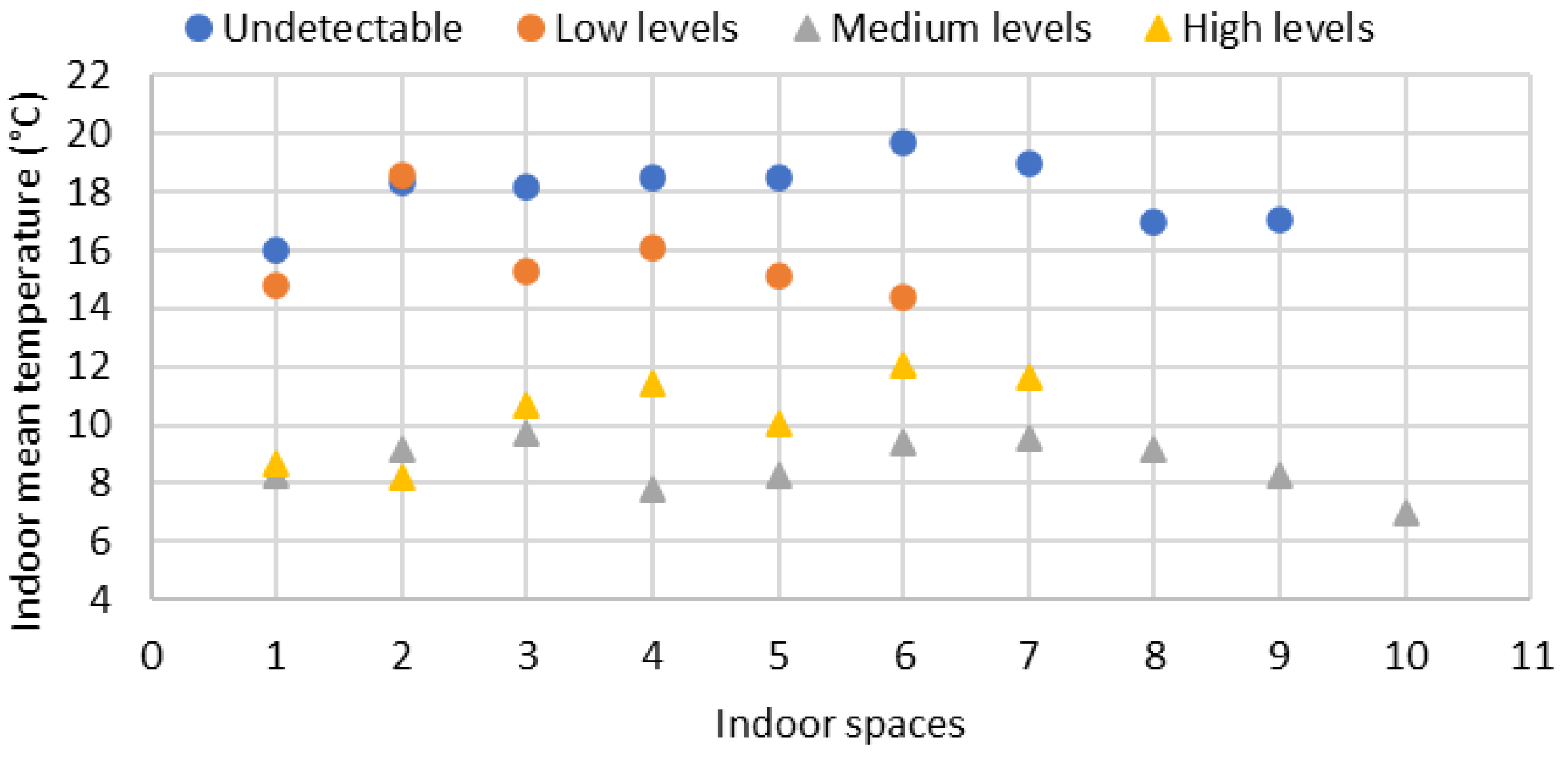1. Introduction
Auckland, New Zealand, has a temperate climate with warm, dry summers and mild, wet winters [
1]. Most of the factors that contribute to poor health, for example, bacteria, viruses, fungi, mites, etc., have increases associated with high indoor RH [
2]. Indoor dust mite allergens in New Zealand houses are deemed to be the world’s highest levels [
3]. Visible mould on indoor surfaces is common in local homes [
4]. In New Zealand houses, the main indoor allergens from mould and dust mites are related to the high indoor RH. For optimum indoor air quality, RH should be below 60% [
5,
6,
7]. Indirect adverse health effects can be minimised by maintaining indoor RH between 40% and 60% [
2].
Most Auckland houses with internal insulation and external cladding are designed for temporary heating, and their structures are light-frame construction. There are only a small percentage of local homes that have a permanent heating system [
8]. For an Auckland house with recommended insulation in its envelope and a permanent heating system, the minimum indoor temperature must be higher than 20 °C to control indoor mean RH below 50% for minimising indirect adverse health effects [
2,
9]. Since 2007, double-glazed windows and the higher insulation (R2.9 for roofs, R1.9 for walls, R1.3 for floors, and R0.26 for glazing) for the local houses have been required by the building codes [
10,
11]. According to the thermal insulation history of New Zealand houses, there is a large percentage of Auckland houses that do not meet these requirements of the current building codes [
10,
11]. For those houses without the recommended insulation and double-glazed windows, it is difficult and energy inefficient, and also very expensive for the occupants to maintain the minimum indoor temperature above 20 °C for controlling indoor mean RH below 50%. Based on the field study, this study identified the relationship between indoor thermal conditions and the two major indoor allergens in New Zealand houses—dust mites and mould. This study focuses on the minimum indoor thermal conditions required to maintain the major indoor allergens at acceptable levels.
Previous studies in other countries found dust mites cannot survive when indoor RH is lower than 50% [
12,
13]. The presence of dust mites and their allergens can be reduced by maintaining indoor RH below 50%, and when indoor RH is maintained within a range of 40–50%, dust mites can be minimised [
14,
15,
16,
17]. Indoor RH within 60% to 80% are optimal conditions for dust mites’ reproduction. Dust mites need indoor RH within 75% to 80% or higher indoor RH to thrive. They prefer temperatures in the range of 18–25 °C [
2,
14,
15,
18,
19,
20]. Both high ambient temperature and RH could occur during the hot and humid summer of a temperate climate or a tropical climate. The local climate for this study has a high ambient RH and low temperature during the winter and a comfortably warm, dry summer.
The previous study of lab mite cultures showed that the environmental RH for dust mite population at the peak was at about 85% at 28 °C [
21]. Except for indoor RH and temperature, indoor ventilation can also impact the dust mite allergen; high indoor ventilation potentials or high indoor air change rates can reduce indoor dust mite allergen levels [
22,
23]; indoor dust mite allergen levels can also be impacted by occupants’ numbers and daily activities [
24,
25]. Based on the field study data, this study identified four different indoor dust mite allergen levels and their associated indoor thermal conditions. The four different dust mite allergen levels are as follows: undetectable and low (acceptable indoor dust mite allergen levels) and medium and high (unacceptable indoor dust mite allergen levels).
Previous studies in New Zealand have shown that the local homes had generally much higher levels of house dust mite (HDM) allergens than nurseries, kindergartens, and elementary schools [
26,
27,
28]. Home environments had significantly higher dust mite allergens than indoor spaces of public buildings and were primarily affected by floor coverings [
29]. The recent study in another country also showed that dust mite populations in home environments were higher than hotel and school indoor environments [
30]. Those studies did not provide indoor thermal conditions. There are limited data and studies on measurements of indoor thermal environments in New Zealand houses; in particular, information on the relationships between indoor thermal environments, indoor air quality and health is sorely limited regarding New Zealand buildings [
31,
32]. The local previous studies showed that occupants’ poor health conditions were closely related to the poor living conditions of the houses with serious dust mite allergy problems [
33,
34]. This study focused on New Zealand houses and identified indoor thermal conditions related to different indoor dust mite allergen levels. This field study not only tested indoor thermal conditions in sample houses with dust mite allergen problems (unacceptable dust mite allergen levels) but also tested indoor thermal conditions in sample houses without dust mite allergen problems (acceptable dust mite allergen levels). Those thermal conditions of indoor spaces with acceptable dust mite allergen levels can be used as the threshold for keeping indoor allergens at acceptable levels. If the indoor thermal conditions of New Zealand houses can be maintained below the threshold for keeping indoor allergens at acceptable levels, there will be no indoor dust mite allergen problems.
Previous studies showed that mould cannot survive when indoor RH is lower than 60%. Mould can grow on most building materials when indoor RH exceeds 75–80% [
35,
36,
37]. For mould spores to germinate, they require both higher indoor RH than mould survival does and the required time to germinate (
Table 1) [
38]. If indoor thermal conditions can be controlled to prevent mould spores’ germination, the mould hardly grows on the indoor surfaces [
39,
40]. The recent study of mould growths on different building materials in the laboratory environment showed that there is no mould growth on the materials’ surfaces when the RH was lower than 75% and the temperature was at 25 °C [
41]. Those studies found that there are correlations between surface moisture content of the building materials and mould growth under different RH and temperature [
42,
43]. The other recent studies found that the short wavelength light can limit the formation and production of mould spores [
44]; the optimum indoor ventilation condition in a building with an HVAC system can reduce mould growth [
45]. This study focused on the thresholds of indoor thermal conditions for mould germination—not its survival or growth conditions—for preventing mould growth on indoor surfaces. This study also identified the relationships between indoor dust mites and mould under the local climate.
The healthy minimum indoor temperature recommended by WHO is 18 °C for houses and 20–21 °C for older people and young children’s living environments during the winter [
46]. There are 1150 heating degree days for the Auckland climate (the base temperature: 18 °C) [
47]. Previous studies showed that for minimising infections of the respiratory system during the winter, the required minimum indoor temperature is 16 °C [
48,
49]. Previous studies have revealed that winter indoor temperatures of local houses are quite lower than the health minimum indoor temperature recommended by WHO [
50,
51]. Based on data gathered from about 400 sample houses throughout New Zealand, mean winter living room and bedroom temperatures are below 18 °C. Mean living room and bedroom temperatures are 12.6–13.5 °C during the morning, 14.2–15.8 °C during the day, 15.0–17.8 °C during the evening, and 13.6–14.8 °C during the night [
11]. As indoor temperature decreases, this is associated with an increase in indoor RH; very low indoor temperature can result in very high indoor RH. As occupants only use temporary heating in their living rooms and bedrooms when they are occupied during the winter or as needed, it is difficult to maintain winter indoor temperature above the healthy minimum indoor temperature recommended by WHO for 24 h a day in winter. This study tried to identify the minimum requirement of indoor temperature for maintaining the two major indoor allergens from dust mites and mould at the acceptable levels in New Zealand housing.
2. Materials and Methods
According to the instructions on how to use the Ventia Rapid Allergen Test, dust samples in the carpets of indoor spaces were collected by a vacuum cleaner with a DUSTREAM® collector (InBio, Charlottesville, VA, USA). In a bedroom, the area of carpet sampled was beside the bed. In a living room, the areas of carpet sampled were in front of the sofa or in the centre of a living room. The total testing area in a bedroom or a living room is about 1 m2. The continued vacuuming time for the sampling area of each room is 2 min. The Ventia Rapid Test cassettes were used for testing dust samples. The four different dust mite allergen levels—(1) undetectable; (2) low (less than 0.2 micrograms of dust mite allergens per gram of dust); (3) medium (0.2–1.0 micrograms of dust mite allergens per gram of dust); (4) high (≥1 microgram of dust mite allergens per gram of dust)—can be identified. According to the instructions of the Ventia Rapid Test cassettes, for Levels 1 and 2, no action is needed to reduce indoor levels of dust mite allergens (acceptable levels); for Levels 3 and 4, action should be taken to reduce indoor levels of dust mite allergens to protect occupants’ health (unacceptable levels). Undetectable and low dust mite allergens are considered acceptable; medium and high dust mite allergens are considered unacceptable for this study.
In accordance with the instructions of consulting industrial microbiologists Biodet Services Ltd. (Auckland, New Zealand), mould samples were collected by the researchers, using clear, standard Sellotape, from the indoor surface areas with visible mould in the indoor spaces. The mould samples on the Sellotape were then wrapped in the baking paper and put in the plastic bags; the samples were examined both macroscopically and microscopically by a local testing laboratory.
HOBO UX100 Temp/RH Data Loggers (Onset, Bourne, MA, USA) were used for the field studies of indoor thermal conditions (tested indoor thermal environment: −20 to 70 °C; for the temperature range of 0–50 °C, the accuracy is ±0.21 °C; for RH, the range is 15–95%, the accuracy is ±3.5%; the maximum data memory is 84,650; and the testing intervals can be set from 1 s to 18 h). Air temperatures and RH close to ceilings and floors in the indoor spaces (living rooms or bedrooms) and in the outdoor spaces under the roof eaves on the south sides of sample houses were continuously tested during the winter (15 min intervals and 24 h per day). The indoor measuring points adjacent to the ceilings and the floors were generally located at the room centres. Indoor measuring points adjacent to the floors of the north living room or bedroom could be located close to the south internal walls for avoiding direct sunlight. The outdoor measuring points under the roof eaves were on the south sides of houses, which can minimise the impact of solar gain during the daytime. There are about 635,904 raw data of indoor and outdoor temperatures and RH from the field studies of the 16 sample houses. Based on the field study data, winter indoor mean temperatures and RH, and winter indoor mean temperatures and RH close to the ceilings and the floors of the indoor spaces with different dust mite allergen levels in the new and old sample houses were calculated. Average outdoor temperature and RH for the new sample houses or the old sample were calculated and used for the outdoor reference data. All field study data of indoor and outdoor air temperatures (mean, close to ceiling and close to floor) have been converted into percentages of time in winter when air temperatures are greater than or equal to 16 °C, 17 °C, 18 °C, 20 °C, and 22 °C; all field study data of indoor and outdoor RH have been converted into percentages of time in winter when RH is greater than or equal to 40%, 50%, 60%, 70%, 75%, 80%, and 90% for the purposes of comparing indoor thermal conditions of indoor spaces with different dust mite allergen levels and mould growths in the new and old sample houses.
Indoor thermal environmental data of 17 indoor spaces (living rooms or bedrooms) in 11 old sample houses (floor areas from 51 m
2 to 106 m
2) with unacceptable dust mite allergen levels (medium and high levels) and mould growth present on internal surfaces in the remote sites of Minginui, Te Whaiti, and Murupara areas were used for the study. Dust mite allergen tested results in all the 7 indoor spaces of the five old sample houses were high levels; dust mite allergen tested results in all the 10 indoor spaces of the six old sample houses were medium levels. Indoor thermal environmental data in 15 indoor spaces (living rooms or bedrooms) of five new houses with acceptable dust mite allergen levels (undetectable and low levels) in Auckland city were used for the study. Dust mite allergen tested results in the 9 indoor spaces of the five new sample houses were undetectable levels; dust mite allergen tested results in the 6 indoor spaces of the four new sample houses were low levels. Dust mite tested results in all the indoor spaces of one new sample house were undetectable levels only; dust mite tested results in the indoor spaces of the other four new sample houses were both undetectable and low levels.
Figure 1 and
Figure 2 illustrate Auckland and Rotorua climate data. The remote field study sites in Minginui are near Rotorua.
The 11 old sample houses built from the 1920s to the 1970s have light timber structures and single-glazed windows. Roofing materials are old asbestos cement sheets (one house), old, corrugated iron (four houses) and old roof tin shingles (six houses). Wall materials are old brick (one house) and old weatherboard (ten houses). The 11 old sample houses do not have sufficient insulation (eight houses without any insulation and three houses with limited insulation). One house used an electric heater and a fireplace for space heating. Two sample houses used stoves for both cooking and space heating. Eight houses used fireplaces for space heating.
The five new sample houses (floor areas from 210 m
2 to 256 m
2) in Auckland, with a light timber structure, were built in the 2000s (2000–2018). Roofing materials are tile (four houses) and felt (one house). Wall materials are brick veneer and weatherboard (three houses) and polystyrene insulation board (two houses). Three houses have basic insulation (R1.9 for roofs, R1.5 for walls, and R1.3 for floors) [
52] and single-glazed windows. Two houses have sufficient insulation (R2.9 for roofs, R1.9 for walls, R1.3 for floors, and R0.26 for glazing) [
8,
9] and double-glazed windows. For space heating, three sample houses used portable electric heaters, and two sample houses temporarily used heat pumps. The field studies of measuring indoor thermal conditions and testing for dust mite allergens in the old sample houses and new sample houses were carried out in the winter months (June, July, and August) in 2018 [
34] and 2022, respectively, by the authors.
4. Conclusions
Based on the field studies, this study contributes the new physical data of winter indoor thermal conditions of the indoor spaces with four different dust mite allergen levels in New Zealand houses under a temperate climate with mild and wet winters. For maintaining indoor dust mite allergens at acceptable levels, the mean indoor RH does not have to be controlled below the conditions for dust mites to survive (50%) or the ideal conditions for dust mites to grow (60%). There were clear differences of mean indoor RH between the indoor spaces with acceptable and unacceptable dust mite allergen levels. There were significant differences in percentages of time in winter between the indoor spaces with acceptable and unacceptable dust mite allergen levels when the indoor RH was higher than or equal to 75–80% (the conditions for dust mites to thrive).
This study identified thresholds of indoor mean temperatures and percentages of time in winter when indoor RH is higher than or equal to 70% and 75% to maintain indoor dust mite allergens at the acceptable levels (undetectable and low dust mite allergen levels). This study provides a new method to identify the relationships between indoor thermal conditions and indoor dust mite allergen levels. The relationships can serve as guidelines to maintain indoor dust mite allergens at acceptable levels.
If the RH close to the floor can be maintained to keep dust mite allergens in the carpet at the acceptable levels, and the indoor RH never meets the conditions for mould spores to germinate, there will be no mould growth or allergy problems. The main indoor allergens from dust mites and mould can be prevented at the same time in New Zealand housing. Maintaining the indoor air temperature above 16 °C should be the starting point for New Zealand houses to phase in the reduction of indoor allergens from dust mites and mould.
